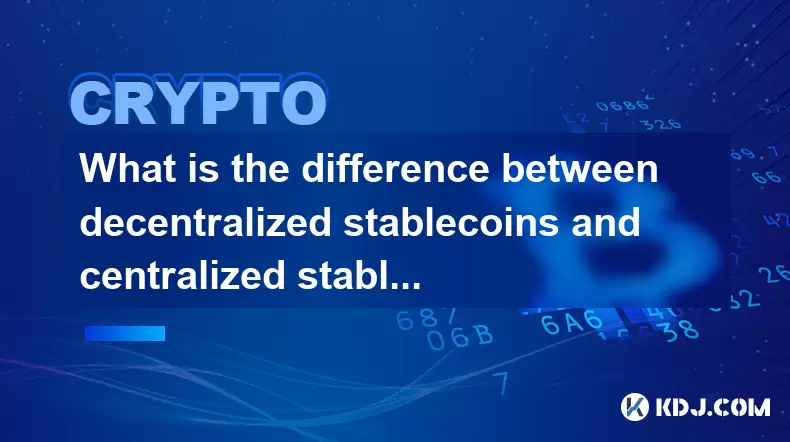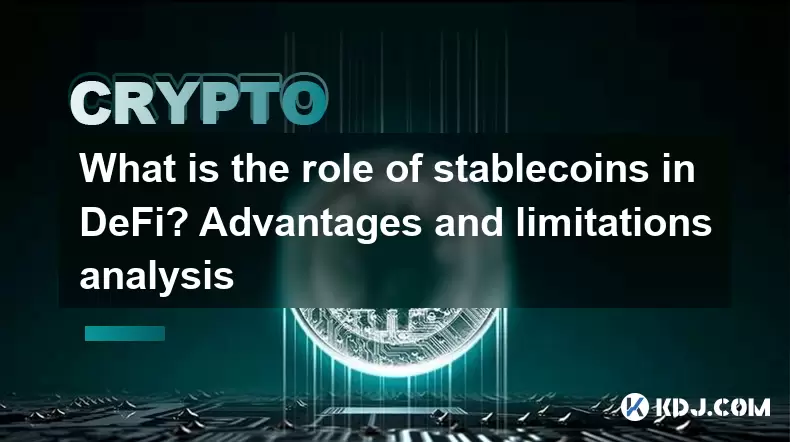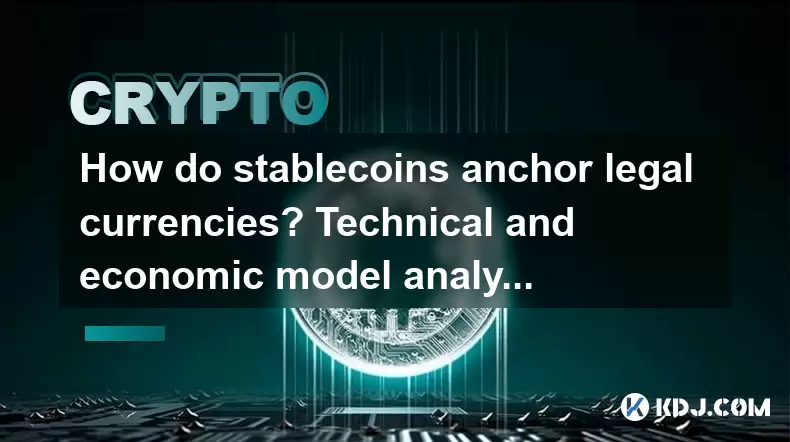-
 bitcoin
bitcoin $124586.364639 USD
0.62% -
 ethereum
ethereum $4670.671710 USD
3.33% -
 xrp
xrp $2.983701 USD
0.18% -
 tether
tether $1.000175 USD
-0.03% -
 bnb
bnb $1209.430642 USD
2.76% -
 solana
solana $231.365861 USD
0.51% -
 usd-coin
usd-coin $0.999665 USD
-0.02% -
 dogecoin
dogecoin $0.264657 USD
4.46% -
 tron
tron $0.346415 USD
1.60% -
 cardano
cardano $0.871586 USD
3.70% -
 chainlink
chainlink $23.451270 USD
7.56% -
 hyperliquid
hyperliquid $46.860071 USD
-2.96% -
 ethena-usde
ethena-usde $1.000120 USD
0.04% -
 sui
sui $3.611279 USD
1.08% -
 stellar
stellar $0.407149 USD
0.96%
How do algorithmic stablecoins work? Potential risks and market impact
Algorithmic stablecoins use smart contracts to maintain value stability, but their reliance on market confidence and complex mechanisms poses risks like the 2022 TerraUSD collapse.
Jun 12, 2025 at 02:07 pm

Understanding Algorithmic Stablecoins
Algorithmic stablecoins are a type of cryptocurrency designed to maintain a stable value relative to a specific asset, usually the US dollar. Unlike traditional stablecoins like Tether (USDT) or USD Coin (USDC), which are backed by reserves such as cash or short-term bonds, algorithmic stablecoins rely on smart contracts and complex algorithms to manage supply and demand dynamics.
These stablecoins use automated mechanisms to adjust the circulating supply based on price fluctuations. When the price rises above the peg, new coins are minted and sold to bring it back down. Conversely, when the price falls below the peg, coins are bought back and burned to reduce supply. This system mimics central bank monetary policy but in a decentralized manner.
Key Components of Algorithmic Stablecoin Models
Most algorithmic stablecoins operate using at least two tokens: the stablecoin itself and a governance or seigniorage token. The governance token plays a crucial role in stabilizing the price of the stablecoin by incentivizing users to participate in the rebalancing process.
The core mechanism involves:
- Minting and burning: Users can mint new stablecoins by locking up governance tokens or other assets.
- Arbitrage opportunities: Traders are encouraged to profit from price discrepancies between the stablecoin and its peg, thereby helping restore equilibrium.
- Rewards and penalties: Participants who contribute to maintaining the peg are rewarded with additional tokens, while deviations may result in penalties or reduced rewards.
This dual-token model is essential for ensuring that the stablecoin remains functional even during volatile market conditions.
Risks Associated with Algorithmic Stablecoins
Despite their innovative design, algorithmic stablecoins come with significant risks. One of the most notable is the potential for a death spiral, where confidence in the system collapses, leading to rapid devaluation.
Because these stablecoins are not backed by real-world assets, they depend heavily on market sentiment and user trust. If the price drops below $1 and users lose faith, selling pressure increases, making it harder to recover the peg. This was evident during the collapse of TerraUSD (UST) in 2022, where the stablecoin lost its peg and triggered a broader market crash.
Other risks include:
- Smart contract vulnerabilities: Bugs or exploits in the code can lead to loss of funds.
- Regulatory uncertainty: Governments may impose restrictions due to concerns about financial stability and consumer protection.
- Liquidity issues: During periods of high volatility, there may not be enough liquidity to support the peg effectively.
Market Impact of Algorithmic Stablecoins
Algorithmic stablecoins have had a profound impact on the cryptocurrency ecosystem. They represent an attempt to create a decentralized alternative to fiat-backed stablecoins, promoting financial sovereignty and programmability within DeFi applications.
Their introduction has led to increased innovation in stablecoin design, including hybrid models that combine algorithmic mechanisms with partial collateral backing. However, their failures have also contributed to heightened skepticism around stablecoins as a whole.
In some cases, algorithmic stablecoins have driven significant trading volume and liquidity on decentralized exchanges. Their presence has enabled more efficient capital allocation across lending protocols, yield farms, and synthetic asset platforms. Yet, the instability associated with certain projects has caused ripple effects across the market, affecting investor confidence and regulatory scrutiny.
Use Cases and Adoption Challenges
While algorithmic stablecoins aim to provide a scalable and decentralized solution for digital payments and DeFi integration, adoption has been mixed. Some projects have seen moderate success in niche markets, particularly among yield farmers and arbitrageurs.
However, widespread acceptance remains limited due to:
- Trust issues: Without tangible backing, users are hesitant to hold or transact with them.
- Volatility risk: Even minor fluctuations can deter usage in everyday transactions.
- Complexity: Understanding how these systems work requires technical knowledge that many users lack.
For these stablecoins to gain mainstream traction, they must demonstrate consistent stability over time and establish robust mechanisms to withstand extreme market conditions.
Frequently Asked Questions
What happens if an algorithmic stablecoin loses its peg permanently?If an algorithmic stablecoin fails to return to its peg, it can lead to a cascading loss of confidence. Holders may rush to exit, and the underlying protocol may become insolvent, especially if no reserve assets back the system.
Are all algorithmic stablecoins uncollateralized?Not all of them. Some newer models incorporate partial collateralization, combining algorithmic adjustments with reserve assets to enhance stability. These hybrids aim to balance decentralization with reliability.
How do arbitrageurs help stabilize the price of algorithmic stablecoins?Arbitrageurs exploit price differences between the stablecoin’s market price and its intended peg. For example, if the stablecoin trades at $0.95, arbitrageurs can buy it and redeem it for $1 worth of governance tokens, profiting from the difference while reducing selling pressure.
Can algorithmic stablecoins be regulated like traditional financial instruments?Regulators are increasingly scrutinizing stablecoins due to their systemic importance. While fully algorithmic versions pose challenges due to their decentralized nature, governments may impose rules around transparency, reserves, and disclosures for projects seeking legitimacy.
Disclaimer:info@kdj.com
The information provided is not trading advice. kdj.com does not assume any responsibility for any investments made based on the information provided in this article. Cryptocurrencies are highly volatile and it is highly recommended that you invest with caution after thorough research!
If you believe that the content used on this website infringes your copyright, please contact us immediately (info@kdj.com) and we will delete it promptly.
- BlockDAG, DOGE, HYPE Sponsorship: Crypto Trends Shaping 2025
- 2025-10-01 00:25:13
- Deutsche Börse and Circle: A StableCoin Adoption Powerhouse in Europe
- 2025-10-01 00:25:13
- BlockDAG's Presale Buzz: Is It the Crypto to Watch in October 2025?
- 2025-10-01 00:30:13
- Bitcoin, Crypto, and IQ: When Genius Meets Digital Gold?
- 2025-10-01 00:30:13
- Stablecoins, American Innovation, and Wallet Tokens: The Next Frontier
- 2025-10-01 00:35:12
- NBU, Coins, and Crypto in Ukraine: A New Yorker's Take
- 2025-10-01 00:45:14
Related knowledge

What is the difference between decentralized stablecoins and centralized stablecoins? Pros and cons comparison
Jun 15,2025 at 09:42am
What Are Stablecoins and Why Do They Matter?Stablecoins are a category of cryptocurrencies designed to maintain a stable value, usually pegged to an e...

What is the role of stablecoins in DeFi? Advantages and limitations analysis
Jun 14,2025 at 06:28am
Understanding Stablecoins in the DeFi EcosystemStablecoins play a pivotal role in the decentralized finance (DeFi) landscape by providing a bridge bet...

How do algorithmic stablecoins work? Potential risks and market impact
Jun 12,2025 at 02:07pm
Understanding Algorithmic StablecoinsAlgorithmic stablecoins are a type of cryptocurrency designed to maintain a stable value relative to a specific a...

How do stablecoins anchor legal currencies? Technical and economic model analysis
Jun 16,2025 at 08:43am
Understanding the Concept of StablecoinsStablecoins are a category of cryptocurrencies designed to maintain a stable value relative to a specific asse...

How do stablecoins maintain price stability? Principles and risk analysis
Jun 11,2025 at 12:01am
Understanding the Mechanisms Behind Stablecoin StabilityStablecoins are a category of cryptocurrencies designed to minimize price volatility, often pe...

What is the operating mechanism of stablecoins? In-depth exploration of its stability principle
Jun 10,2025 at 09:28pm
Understanding the Core Concept of StablecoinsStablecoins are a unique category within the cryptocurrency market, designed to address one of the most s...

What is the difference between decentralized stablecoins and centralized stablecoins? Pros and cons comparison
Jun 15,2025 at 09:42am
What Are Stablecoins and Why Do They Matter?Stablecoins are a category of cryptocurrencies designed to maintain a stable value, usually pegged to an e...

What is the role of stablecoins in DeFi? Advantages and limitations analysis
Jun 14,2025 at 06:28am
Understanding Stablecoins in the DeFi EcosystemStablecoins play a pivotal role in the decentralized finance (DeFi) landscape by providing a bridge bet...

How do algorithmic stablecoins work? Potential risks and market impact
Jun 12,2025 at 02:07pm
Understanding Algorithmic StablecoinsAlgorithmic stablecoins are a type of cryptocurrency designed to maintain a stable value relative to a specific a...

How do stablecoins anchor legal currencies? Technical and economic model analysis
Jun 16,2025 at 08:43am
Understanding the Concept of StablecoinsStablecoins are a category of cryptocurrencies designed to maintain a stable value relative to a specific asse...

How do stablecoins maintain price stability? Principles and risk analysis
Jun 11,2025 at 12:01am
Understanding the Mechanisms Behind Stablecoin StabilityStablecoins are a category of cryptocurrencies designed to minimize price volatility, often pe...

What is the operating mechanism of stablecoins? In-depth exploration of its stability principle
Jun 10,2025 at 09:28pm
Understanding the Core Concept of StablecoinsStablecoins are a unique category within the cryptocurrency market, designed to address one of the most s...
See all articles










































































